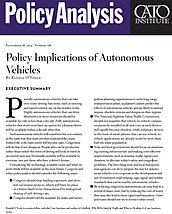Partially autonomous vehicles that can take over some driving functions, such as steering and speed control, are on the market today. Highly autonomous vehicles that can drive themselves in most situations should be available for sale in less than a decade. Fully autonomous vehicles that won’t even have an option for a human driver will be available within a decade after that.
Such autonomous vehicles will transform the 21st century in the same way that mass-produced automobiles transformed the 20th. Auto travel will become safer. Congestion will decline if not disappear. People who can be productive rather than endure the stress of driving will look at travel in an entirely new way. Eventually, mobility will be available to everyone, not just those who have a driver’s license.
Considering the technology available today and what experts think will be available in the near future, Congress and other policymakers should consider the following steps:
- Congress should stop funding expensive and obsolete rail transit projects, which will have no place in a future likely to be characterized by widespread sharing of self-driving cars.
- Congress should end the mandate for states and metropolitan planning organizations to write long-range transportation plans, as planners cannot predict the effects of autonomous vehicles and are likely to instead impose obsolete systems and designs on their regions.
- The National Highway Safety Traffic Commission should not mandate that vehicle-to-vehicle communications be installed in all new cars, as such devices will rapidly become obsolete, while voluntary devices in the form of smart phones that can use vehicle-to vehicle applications are already in use by more than half the adult population.
- State and local governments should focus on maintaining existing infrastructure and making cost-effective improvements, such as dynamic traffic signal coordination, to alleviate today’s safety and congestion problems. The best thing state and local transportation agencies can do to prepare the way for autonomous vehicles is to cooperate in the development and use of consistent road striping, sign, signal, and similar standards that can be read by autonomous vehicles.
- By reducing congestion, autonomous cars may lead to a revival of inner cities, but by reducing the cost of travel, they may also lead to more rapid exurbanization. Cities and states should not try to restrict either trend.

This work is licensed under a Creative Commons Attribution-NonCommercial-ShareAlike 4.0 International License.

